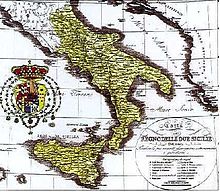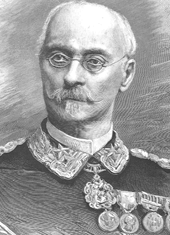Scuola Militare Nunziatella
The Scuola Militare Nunziatella ( German Military School Nunziatella ) is a cadet institute of the Italian Army and is based in Naples .
Registered office and name
The military school, founded in 1787, is housed in a former Jesuit convent to which the small Annunziata Church ( Annunciation ) is attached. In the Neapolitan vernacular , this is called nunziatella , also to distinguish it from a larger church of the same name ( Santissima Annunziata Maggiore ) in the city center. This dialect expression later became part of the military school's official name.
The school in Naples has additional modern facilities. After extensive renovation and conversion work, the school will also be able to use the Caserma Nino Bixio in a few years .
education
At the Nunziatella Military School , young people can complete the three-year upper secondary school and take the Abitur . You can choose between a humanistic and a scientific branch. The lessons are mainly given by civil grammar school teachers. All students are required to attend physical education and military training in the afternoons. The school is on an equal footing with other state secondary schools . Since it is a military training facility, the 16 to 19 year old students also have the status of soldiers and wear uniform. After successfully completing school, students can either return to civilian life or pursue a military career and, for example, train to become officers at the Accademia Militare di Modena . In this case, the officer applicants have to undergo a selection process like all other applicants, but receive bonus points due to their special school leaving certificate.
In addition to the Nunziatella Military School, the Italian Army maintains another cadet school, the Teuliè Military School, founded in Milan in 1802 . Both are subordinate to the Army Training Command. A third military school, the Collegio Militare di Roma , existed in Rome until 1943 . The Armed Forces Command Academy is located in its building today .
In addition to the two cadet departments of the army, there is a corresponding school in the navy , the Scuola Navale Militare Francesco Morosini in Venice , and one in the air force , the Scuola Militare Aeronautica Giulio Douhet in Florence .
history
Of all current Italian cadet institutions, the nunziatella is the most traditional. It originated in what was then the Bourbon Kingdom of Naples , which was founded under Charles III. had achieved a certain independence. Charles III began in the course of his reform policy, among other things, with the establishment of his own armed forces, for which he also set up some schools, including the Naval Academy founded in 1735 , whose tasks were taken over in 1881 by the Italian Accademia Navale . The artillery school was opened in 1736, the academy for mathematics in 1745 and the academy for military engineers in 1754 .
The merger of the latter three schools officially gave rise to the new royal military academy on November 18, 1787 , the Real Accademia Militare , which was later renamed Real Collegio Militare and then as a cadet institute was given the current name Scuola Militare Nunziatella . In fact, the artillery and engineering schools merged to form the military academy as early as 1769.
In 1756, in the Kingdom of Sardinia-Piedmont, the Real Accademia di Savoja, founded in Turin in 1678, was converted into a pure military academy, which continues to exist today as the Accademia Militare di Modena . Depending on how you look at it, one of the two military academies in Naples or Turin was or is the oldest army officer school in Italy.
The Royal Military Academy in Naples was able to move into the Jesuit Convention shortly after its establishment, where it is still located today as the Nunziatella Military School, as King Ferdinand IV had expelled all Jesuits from the country in 1767. In the complex of today's military school, prospective religious had to complete their novitiate at the time.
Between 1782 and 1784 the new military academy sent a group of officers to the most famous officers' schools in Europe to report on their methods and experiences. The results of this study trip contributed to the fact that the Military Academy of Naples remained by far the best institution of the army until the fall of the Kingdom of the Two Sicilies in 1861 and did not have to shy away from comparison with the officer schools of other European armed forces. Even during the Napoleonic period (1799-1815) it was only closed for a short time and then expanded by Joachim Murat as a polytechnic military school based on the French model . Finally, Murat formed his bodyguard with the students .
After 1815, the returned King Ferdinand IV initially retained the academy in its Napoleonic form. However, it soon became a center of resistance against the Restoration and more and more of its students and lecturers later joined the Italian unification movement. In 1819 the king divided the school: the Real Collegio Militare remained in the same place , where the offspring of officers for the artillery and the pioneer troops were trained, while the new "military academy" in the convent of San Giovanni a Carbonara was responsible for the officer candidates of all other troops . As early as the following year, 1820, the Real Collegio Militare in particular started the uprising against the Bourbons, organized by General Guglielmo Pepe , which forced the king to issue a constitution . In 1821 the liberal movement in Naples was crushed by the Austrians, following the policy of the Holy Alliance . The purges carried out by the king afterwards hit the military academies hard. In 1823 the pre-Napoleonic, militarily proven, but politically outdated educational principles were reintroduced in the Real Collegio Militare . For a few years it also trained naval officers. Thanks to capable, Italian-friendly lecturers, the school provided good offspring of officers until 1861, although they were predominantly anti-Bourbon. Among the lecturers at the time was the philosopher Francesco De Sanctis . After the King of Naples moved to the Palace of Caserta , from 1855 to 1859 he also temporarily relocated the Real Collegio Militare to nearby Maddaloni (today the headquarters of the Army Administration School). In 1860 it was mainly the officers trained by this institute who went with their soldiers against Giuseppe Garibaldi's red shirts in the battle of the Volturno and then defended the king in the fortress of Gaeta , even though they were actually for the unification of Italy. Some of them had fought against the Austrians under Daniele Manin in Venice in 1848 and 1849 .
After the unification of Italy under the House of Savoy , the Real Collegio Militare fell into displeasure with the government in Turin because the academy and its graduates were mistakenly believed to be thoroughly bourbon-friendly. For this reason, the King of Italy ordered the academy to be renamed from Real Collegio Militare to Collegio Militare di Napoli . With the loss of the attribute “royal”, the demotion to the more preparatory cadet institute went hand in hand (at that time the lower secondary school), a function that today's military school still has in a similar form. The military academy in Turin was given sole responsibility for the basic training of all officer candidates in the Italian army (which at that time included the upper secondary school level).
In 1869 the now existing Collegio Militare di Milano in Milan was dissolved. Its 59 students were accepted by the Collegio in Naples. As a result, the planned closure of the school in Naples could only be prevented by the intransigence of southern Italian MPs. After the Savoy had realized that they had miscalculated in the assessment of the school, in 1881 they wrote to the Crown Prince and later King Victor Emanuel III. at the Collegio Militare di Napoli and organized a big festival in 1887 to mark the centenary of the school. 1882 was the Neapolitan Enrico Cosenz , a graduate of the College and one of the most Italian generals of his time, for the first Chief of Staff appointed the army. In the years that followed were graduates of the Collegio repeatedly chief of staff, including Alberto Pollio (1908-1914). During the Second World War the school was moved to Benevento for a short time . In 1953 the school took on its current name Scuola Militare Nunziatella , and in the following year it received a coat of arms with the motto preparo alla vita ed alle armi ("I prepare for life and for arms").
In 1996 the army reopened the old military school in Milan, founded in 1802 by General Pietro Teuliè as a war orphanage, which was an Austrian cadet institution from 1831 to 1848 and later trained cadets for Italy from 1859 to 1869, from 1873 to 1894 and from 1935 to 1943 . There were comparable institutions in Italy in the second half of the 19th century in Asti (1858–1866, before that in Racconigi since 1834 ), Parma (1860–1864, before in Colorno ), Florence (1849–1894; before that, cadet college), Rome (1886–1943; before that, Papal Cadet Institute until 1863), Messina (1883–1895) and Palermo ( Istituto Militare Garibaldi , 1860–1868, before that in Monreale for NCOs). Depending on the anciency , the schools were given a number that was or is to be seen on the pupils' headgear. The Nunziatella has been number 1 since the unification of Italy, in the first half of the 20th century the Collegio Militare in Rome had the 2, that in Milan the 3. Since the school in Rome no longer exists, the 2 was reactivated in 1996 School in Milan.
Especially at the Nunziatella , the navy and the air force trained cadets until they set up military schools of this type themselves. From 1937 to 1943 the navy was able to rely on two naval cadet institutes in Venice and Brindisi, which belonged to a fascist youth organization. In 1961 she opened her own school on the site of the former institute in Venice, today's Scuola navale militare Francesco Morosini , which sees itself as the successor to a Venetian naval school founded in 1619 . The Air Force only moved in 2006 with the Scuola militare aeronautica Giulio Douhet in Florence.
See also
- Chiesa della Nunziatella (the associated church)
- Franco Angioni (graduate, general, 1982–1984 commander in Lebanon )
- Rolando Mosca Moschini (graduate, Chief of Staff of the Armed Forces, 2001-2004, former President of the EU Military Committee )
literature
- Gustavo Ascione, Giuseppe Catenacci, Carlo Pascucci (eds.): Albo ex allievi scuola militare Nunziatella . Associazione Nazionale “Nunziatella”, Naples 1990 ( Biblioteca di studi e documentazioni sulla Scuola militare Nunziatella 10).
- Giuseppe Catenacci, Roberto Selvaggi: Il Real Collegio Militare della Nunziatella a Maddaloni. 1855-1859 . Associazione Nazionale “Nunziatella” and others, Naples and others 1992 ( Biblioteca di studi e documentazione sulla Scuola militare Nunziatella 14).
- Giuseppe Catenacci (Ed.): Mariano d'Ayala e la Nunziatella . Associazione Nazionale “Nunziatella”, Naples 1989 ( Biblioteca di studi e documentazione sulla Scuola militare Nunziatella 5).
- Sandro Castronuovo: Storia della Nunziatella . Fiorentino, Naples 1970.
- Renata Pilati. La Nunziatella. L'organizzazione di un'Accademia Militare. 1787-1987 . Guida, Naples 1987, ISBN 88-7042-903-2 ( Biblioteca di studi e documentazioni - Scuola militare Nunziatella ).
- Aldo De Simone, Roberto Giusti (ed.): Museo storico. Scuola Militare Nunziatella. Catalogo . Sergio Civita Editore, Naples 1988, ISBN 88-85850-18-9 .




